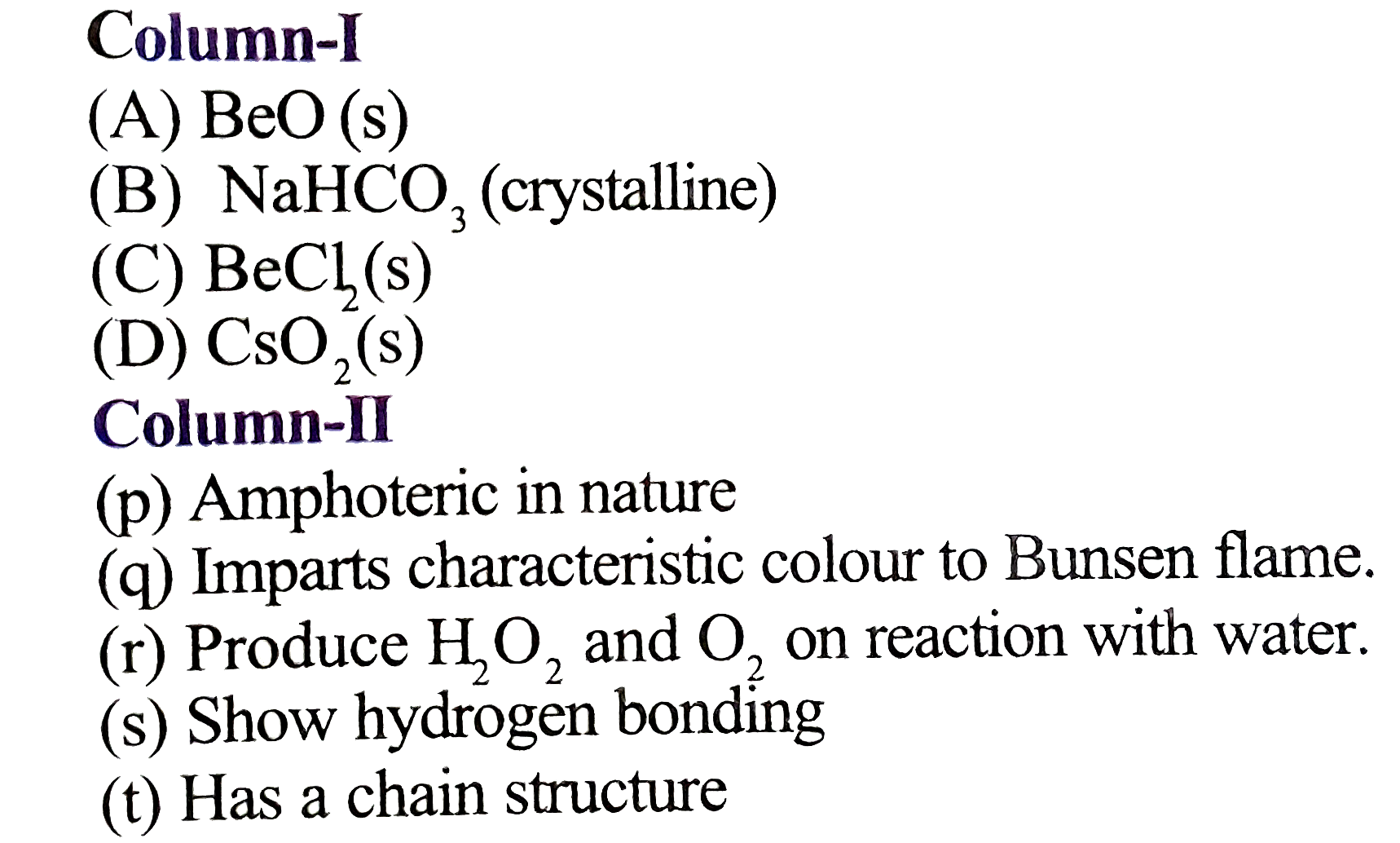Match the characteristics mentioned in Column II with the process in Column I.
Column IColumn II(A)LiF(s)+Aqua→LiF(aq)(p)Exothermic(B)KF(s)+Aqua→KF(aq)(q)Endothermic(C)O(g)+e−→O−(g)(r)Positive affinity(D)O−(g)+e−→O2−(g)(s)Negative affinity
The correct Answer is:A, B, C, D
To solve the problem of matching the characteristics in Column II with the processes in Column I, we will analyze each process and determine the corresponding characteristic based on the principles of thermodynamics and electron affinity.
1. Process A: LiF(s) + H2O → LiF(aq)
- When solid lithium fluoride (LiF) dissolves in water, it forms aqueous lithium fluoride.
- The process involves hydration energy, which is the energy released when ions are surrounded by water molecules.
- Since the hydration energy is greater than the lattice energy (energy required to separate the ions in the solid), this reaction is exothermic.
- Match: A → P (Exothermic)
2. Process B: KF(s) + H2O → KF(aq)
- Similar to LiF, solid potassium fluoride (KF) dissolves in water to form aqueous KF.
- However, in this case, the hydration energy is less than the lattice energy. Therefore, energy must be supplied for the dissolution to occur, making this process endothermic.
- Match: B → Q (Endothermic)
3. Process C: O(g) + e⁻ → O⁻(g)
- This process involves the addition of an electron to a neutral oxygen atom to form an oxide ion (O⁻).
- The energy change associated with this process is known as electron affinity. For oxygen, this process releases energy, indicating a positive affinity.
- Match: C → R (Positive affinity)
4. Process D: O⁻(g) + e⁻ → O²⁻(g)
- In this case, we are adding another electron to the already negatively charged oxide ion (O⁻) to form a doubly charged oxide ion (O²⁻).
- This process requires energy because of the electron-electron repulsion (two negatively charged species repel each other), indicating a negative affinity.
- Match: D → S (Negative affinity)
Final Matches:
- A → P (Exothermic)
- B → Q (Endothermic)
- C → R (Positive affinity)
- D → S (Negative affinity)
- When solid lithium fluoride (LiF) dissolves in water, it forms aqueous lithium fluoride.
- The process involves hydration energy, which is the energy released when ions are surrounded by water molecules.
- Since the hydration energy is greater than the lattice energy (energy required to separate the ions in the solid), this reaction is exothermic.
- Match: A → P (Exothermic)
- Similar to LiF, solid potassium fluoride (KF) dissolves in water to form aqueous KF.
- However, in this case, the hydration energy is less than the lattice energy. Therefore, energy must be supplied for the dissolution to occur, making this process endothermic.
- Match: B → Q (Endothermic)
- This process involves the addition of an electron to a neutral oxygen atom to form an oxide ion (O⁻).
- The energy change associated with this process is known as electron affinity. For oxygen, this process releases energy, indicating a positive affinity.
- Match: C → R (Positive affinity)
- In this case, we are adding another electron to the already negatively charged oxide ion (O⁻) to form a doubly charged oxide ion (O²⁻).
- This process requires energy because of the electron-electron repulsion (two negatively charged species repel each other), indicating a negative affinity.
- Match: D → S (Negative affinity)
- A → P (Exothermic)
- B → Q (Endothermic)
- C → R (Positive affinity)
- D → S (Negative affinity)
Topper's Solved these Questions
- CLASSIFICATION OF ELEMENTS AND PERIODIC PROPERTIES BOOK - ERRORLESS CHAPTER - CLASSIFICATION OF ELEMENTS AND PERIODIC PROPERTIES EXERCISE - JEE Section Integer type questions
2 Videos
- CHEMISTRY IN EVERYDAY IN LIFEBOOK - ERRORLESS CHAPTER - CHEMISTRY IN EVERYDAY IN LIFEEXERCISE - Critical Thinking (Objective question )
25 Videos
- COORDINATION CHEMISTRYBOOK - ERRORLESS CHAPTER - COORDINATION CHEMISTRYEXERCISE - JEE(ADVANCED 2018 MORE THAN ONE CHOICE CORRECT ANSWER
1 Videos
Similar Questions
Match the compounds listed in column -I with the characteristic(s) listed in column-II.

View SolutionMatch the complexes listed in column-I with characteristic(s) listed in column-II.

View SolutionMatch the transformation in column I with appropriate option in column II
Column IColumn II(A)CO2(s)→CO2(g)(p)phase transition(B)CaCO3(s)→CaO(s)+CO2(g)(q)allotropic change(C)2H⋅→H2(g)(r)ΔH is positive(D)P(white, solid)→P(red, solid)(s)ΔS is positive(t)ΔS is negative
View SolutionMatch the nature of aqueous solutions of the substances listed in Column I with the character listed in Column II.
Column IColumn II(A)KCN(aq)(p)Strongly basic(B)TiOH(aq)(q)Neutral(C)BeCl2(aq)(r)Weakly basic(D)NaNO3(aq)(s)Weakly acidic
View SolutionMatch the transformation in colums I with appropriate options in column II.
Column IColumn II(A)CO2(s)→CO2(g)(p)phase transition(B)CaCO3(s)→CaO(s)+CO2(g)(q)allotropic change(C)2H.→H2(g)(r)ΔHis positive(D)P(white, solid)→P(red,solid)(s)ΔSis positive(t)ΔSis negative
View SolutionMatch the transformation in colums I with appropriate options in column II.
Column IColumn II(A)CO2(s)→CO2(g)(p)phase transition(B)CaCO3(s)→CaO(s)+CO2(g)(q)allotropic change(C)2H.→H2(g)(r)ΔHis positive(D)P(white, solid)→P(red,solid)(s)ΔSis positive(t)ΔSis negative
View SolutionMatch the compounds in Column I with their characteristic test (s) reaction (0s) given in Column II.

View SolutionMatch the conversions in Column I with the type(s) of reaction(s) given in Column II.
Column IColumnIIA.PbS→PbOp.RoastingB.CaCo3→CaOq.CalcinationC.ZnS→Znr.Carbon reductionD.Cu2S→Cus.Self-reduction
View SolutionMatch the anionic species given in Column I that are present in the ore (s) given in Column II.
Column IColumn IIA.Carbonatep.SideriteB.Sulphideq.MalachiteC.Hydroxider.BauxiteD.Oxides.Calaminet.Argentite
View SolutionMatch the items given in Column I with examples given in Column II.

View Solution
